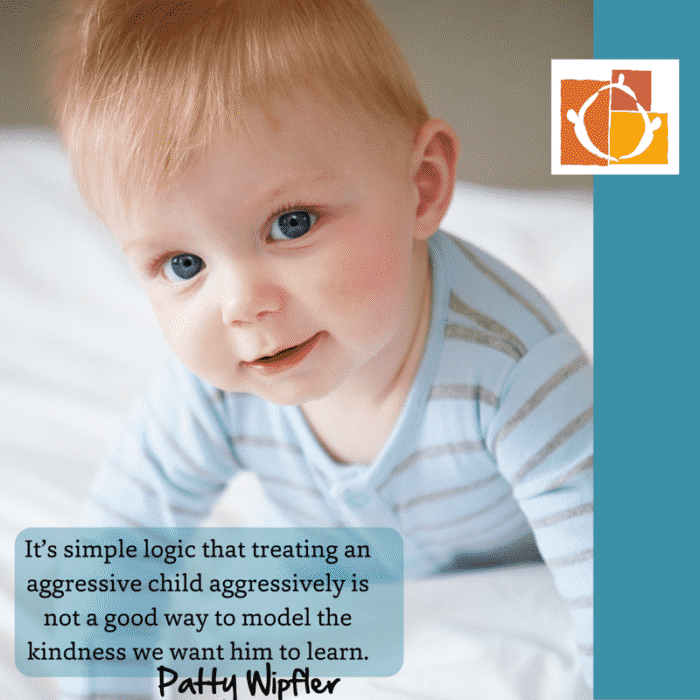Does your toddler suddenly haul back and hit you in the midst of a sweet and playful time together? Or do they impulsively smack other children, even their own siblings?
If your toddler hits, let me reassure you that you haven’t failed at parenting. And when your toddler hits you, your little one isn’t under a mysterious spell.
Your child is good!
Whenever a toddler hits, there are unseen forces at work. Emotional forces. Although your toddler may have a poker face, or might even be laughing as they hit, the aggression is being driven by emotion.
Usually, that emotion is fear.
First and foremost, you need to know that your toddler doesn’t want to hurt you or anyone else, and they certainly don't want to become “the bad kid” in your mind. When your toddler hits they don’t need punishment; in fact, punishment and time out can easily make it more likely that they will hit in the future.
What does your toddler need to stop hitting? Your toddler needs you.
Sometimes when a toddler hits it's experimental. That will subside.
Toddlers are young and eager scientists. They experiment night and day—that’s how they learn how things work. It’s how they build their storehouse of understanding about their parents, their playmates, and how the world around them works. So, news just in, toddlers hit. It's one thing almost every toddler will experiment with.
If it’s your child’s first or second or third hit, take it easy.
The thing to do is to gently, calmly move their arm away from the person they are hitting, so they can’t hit again. You can let them try. Just keep their arm from landing on you or anyone else. Use warm words like, “I can’t let you do that.”
You want to give your toddler information, not a blast of reaction.
If you don’t react wildly (and as long as your toddler isn't witnessing hitting in their daily life), the hitting experiments will play themselves out. After a few tries, it will lose its novelty, and your toddler will move on to climbing, or running, or throwing balls, or playing with the kitty.
Don't know how to respond calmly? This video explores how to stop aggression with play.
If you respond with harshness when your toddler hits, their hitting behavior may persist.
 Odd though it may seem, if you come down hard when your toddler hits, you may very well see more hitting. When we react with upset to our children, they internalize our upset. They add our upsets with them to the number of things that frighten them.
Odd though it may seem, if you come down hard when your toddler hits, you may very well see more hitting. When we react with upset to our children, they internalize our upset. They add our upsets with them to the number of things that frighten them.
Your child may hit again, because they didn’t understand why you yelled, or hit back, or grabbed their arm hard and dragged them to a seat in the corner. Your toddler's mind can’t make sense of your behavior. It scared them, so they return to try it again and again in some effort to make sense of it.
Pretty soon, any time they start feeling alone or scared, their mind will tell them, “Hit. That’s what you do when you feel badly—you hit.”
So the discipline methods many parents consider to be “natural consequences” or “deserved punishments” become part and parcel of a behavior cycle your child falls into more and more, often when they aren't feeling good.
Our children’s fears cause hitting.
Not all children hit when they’re scared—it’s not the only instinctive human reaction to the feeling of fear. But it is one of our innate fear responses. So whether your child smiles while they are hitting, or looks impassive, or only hits when they are clearly upset, you can safely assume that if your child is hitting, it’s because they are feeling scared.
Laughter is one of the ways children release their feelings of fear, so hitting is sometimes accompanied by laughter—your child is trying hard to release tension, but can’t laugh it away fast enough to stop themselves from launching a hit or two.
Most children hide their feelings of fear at an early age. They pick up on our uneasiness with their big feelings. We try to get them not to cry, we distract them when they’re upset, we try to fix things so they won’t have an upset.
Feeling that are repressed don't go away
Most of us parents give at least ten strong signals a day that we don’t like our children to show us how they feel. So their fears go underground, where these powerful feelings cause trouble. They eventually surface not in crying or clinging or a full-out screaming response, but in hitting and biting and pushing other children.
Hidden feelings cause trouble. Hitting is just one sign that a child is troubled by their fears. Waking in the night, tantrums, refusing to try new things, thumb-sucking, and generally picky behavior all can be signs that your child has had to swallow their feelings, and that the stored emotions are hard for them to manage.
Step #1 When your toddler hits: Offer a gentle, attentive barrier.
It’s pretty simple to help a toddler stop impulsive, repetitive hitting. Get close at a time when you think they are likely to hit—anticipating the behavior will help you to respond without reacting. That means you have to notice when your mind starts telling you, “Oh, I wonder if she’ll hit. They getting pretty close to that younger child…I hope they don't!” That thought is your signal to calmly get to your child, and to be ready.
Hope won’t get you to the solution. Preparedness will.
Step #2 Be on Friendly Safety Patrol
Be on friendly safety patrol with your child—get close, be warm, don’t give verbal warnings. Those do nothing to douse the heat of the fear inside that makes them want to hit.
When your toddler's arm reaches out, gently block their thrust with your own arm or hand. Or just hold their hand or arm gently as they approach a playmate, so they can’t strike suddenly. You are the safety manager. It’s your job to insure that no one gets hit.
As they try to strike, just keep the hit from landing, and say gently, “I can’t let you do that.” Then offer eye contact. Stay there. Don’t huff off, don’t scold, don’t say anything else at all. Just hold their arm, gently, and be with them.
Step #3 Upsets find another way out
If you’re quiet and calm, and you’ve gently prevented your child from hitting, the feelings that drive the hitting will bubble up. They’ll feel intensely uncomfortable. They’ll begin to cry, or sweat, or tremble, or fall down in a tantrum.
This, we know, is an odd perspective, but it’s one that makes all the difference: you want their feelings to tumble out in a great big emotional wave. You want all that negative energy out of them, not hiding in the corners of their mind waiting to cause trouble.
Step #4 Listen. Your support is a powerful antidote to the fear that causes hitting.
While your child is upset, it helps them greatly when you can be loving and calm. They won't have to be afraid of your impulsive behavior or your disapproval. Instead, your child can concentrate on letting all that tension tumble out.
Maybe they'll cry. Or they may begin to perspire while they scream. Your child might arch their back in your arms, or throw themselves on the ground. They might kick and flail.
Believe it or not, the more vigorous their reaction, the better the outcome of their emotional episode. They are expelling bad feelings—fear, in particular—using your calm presence as their signal that they are free to let go of the feelings that have infected their behavior.
What to say
Here are some of the things you can say, gently, interspersed with long intervals of simple supportive listening, when your toddler hits. Just talk a bit now and then, to let them know you see how hard they are working to get their fears out of their system:
- “I know you like Jasper and I won’t let you hit them.”
- “No one is mad at you. I will stay right here with you.”
- “I’m right here, keeping you safe.”
- “You’re going to have a good morning with your friends. I’ll stay until things are just right with them.”
- “I’m sorry this is hard. Your day will go well after this.”
- “Whatever scared you is over. It’s not going to happen again.”
- “I think you can have a good time here, in just a while. It’s OK to stay here.”
Listen for 97% of the time, speak with warmth in your voice and a big heart for your struggling child.
It's a natural process
Your child is doing what they were born to do—get rid of stress in a wild but efficient way. If you can anchor them while they do the emotional work, they’ll be a very different little person when they are done. The emotional bad dream will be over. The fear will evaporate—perhaps not all of it, but most likely enough of it that they are able to be happy again, and to have a better day than usual.
Staylistening, (as we call this way of supportive listening), to your child simplifies your life as a parent. Toddlers hit because of “emotional gunk.” You help to clear your child’s mind of emotional gunk, so your child can think more clearly. This means that you don’t need to lecture, you don’t need to recite the principles of proper treatment of friends, you don’t need to list the rules of your household or in the play group, either before, during, or after a hitting incident in which you step in to hold a good limit.
You can trust that your child knows how to treat others well. When they are in their right mind, their rational mind, they will. Your child knows how to be a friend. And by bringing a warm limit, then Staylistening, you help them to reclaim the chance to be in their right mind, free from leftover feelings of fear.
Here’s how it can work.
I went to the park one afternoon with the baby, my toddler son, and his friend. At some point, the friend tried to hit my son when he was on the slide. I gently picked her up off the slide, telling her that I couldn’t let her hurt him or anyone else. She arched back and wailed at the top of her lungs.
I continued to calmly talk to her and tell her that I couldn’t let her hurt herself or anyone else, and tried as gently as I could to maintain physical contact with her body. She screamed, “I want my mommy!” over and over. Certainly if her mother was right there, that would have been fine, but I didn’t feel totally safe walking home with the three kids with her in that state. It was a few blocks and I had the baby in a carrier. I was concerned that she wouldn’t listen to me if I needed her to hold my hand or not run so fast. I softly told her these things.
There was a moment where I tried to give her a little more physical space and she took off running out of the playground towards our home. So I gently gathered her back up, telling her that I couldn't let her go home by herself. The crying, holding and talking went on for quite some time, maybe 20-30 minutes, ebbing and flowing. I wasn’t sure what other parents were thinking. At one point one of the parents looked at me, smiled, and said, “I’m taking notes.”
Additionally, I was intermittently attending to my baby and my son, who sat close to me with a concerned look on his face.
We were now sitting on a bench and she started to tell me that she wanted to go on the swing. I told her that we had to wait until there were two swings available, for both toddlers, and she started to wail again. This ebbed and flowed a few times.
Finally, I felt like we could at least wander over to the swings, and as we got there, the other kid left so she and my son went on the swings together, with me pushing.
When it was time to go home, I asked them if they wanted me to stop the swing for them, or just let it stop by itself. The girl said that she wanted the swing to stop by itself, and slowly, slowly the swing came to a quiet stop. There was something deeply moving about everyone waiting patiently for the swing to stop.
As we walked home, she took my hand. When we got home she easily went to her parents. I took her mother aside and gave her a brief description of what had happened, and the next day I checked in about how her daughter had been that evening. Her mother said that she was super calm and very tired at bedtime.
When I saw her playing in the backyard the next day, she gave me a big hug.
–Laura Podwoski, Berkeley, CA

 Looking for more ideas on how to end aggressive behavior?
Looking for more ideas on how to end aggressive behavior?